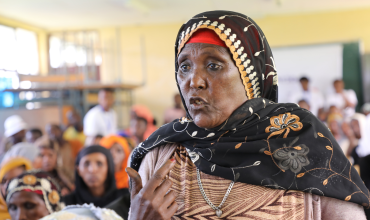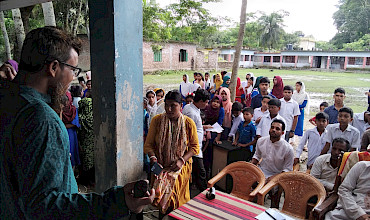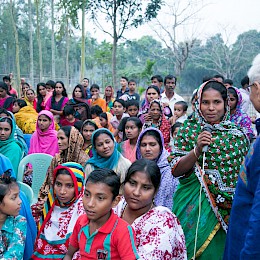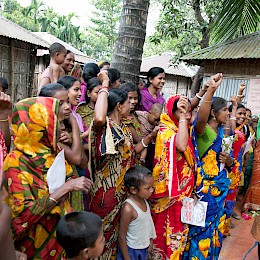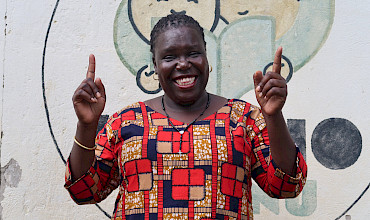
50% of undernutrition is associated with infections caused by poor water, sanitation and hygiene (WASH)[1]. Repeated infection throughout the early years of life, can compromise a child's growth and contribute to chronic undernutrition. The WASH environment is therefore critical in shaping children’s nutritional outcomes. Right2Grow makes use of a multisectoral, community-led approach that integrates WASH and nutrition actions to ensure that every child can reach its full potential.
Bushra is a healthy 5-year-old girl. And if you were to meet her today, you probably would not expect that she had faced health challenges in her earlier years. Born in the Patuakhali district in the southern coastal belt of Bangladesh, she is the daughter of Narul, a small scale poultry farmer, and Mahinur, who runs the household. For a long time, residents from Bushra’s village relied on unsafe drinking water. Private and secure latrines were rare and regular handwashing with soap was not a standard practice. As a result, waterborne diseases such as diarrhoea continued to negatively affect the health of young children, including Bushra, who often fell ill during the early years of her life. At the age of 2, her weight and height were measured for the first time during one of Right2Grow’s courtyard sessions. It was then that her parents learned that she was too short for her age – a condition known as stunting.
Integrated community action
Stunting is an indicator of chronic undernutrition. It refers to the impaired growth and development that children experience as a result of poor nutrition and frequent infections. Compared with a healthy child, a stunted child is more likely to have poorer educational outcomes, less productive abilities and lower adult wages. Poor hygiene habits and faecal contamination of the environment are major factors causing undernutrition in children. Research even reveals that poor sanitation stands as the second leading risk factor for stunting globally[2]. In areas with high stunting rates, such as Bushra’s village, combined WASH and nutrition interventions may therefore provide promising avenues to improve children’s health and nutrition outcomes.
Upon discovering that Bushra was stunted, her mother Mahinur opted to attend the courtyard sessions organised by partner Society Development Agency (SDA) more regularly. There, essential WASH and nutrition practices were jointly promoted, and behavioural change materials helped Mahinur to identify the underlying causes of her daughter's undernutrition. She received information on increasing dietary diversity, safe disposal of faeces, regular handwashing and safe food preparation and storage. Plus, where possible, parents and caregivers exchanged information through peer-to-peer learning. In these cases, the diet of a healthy child living in the same community served as a model for improving diets among undernourished children. Indicating that the ingredients of a healthy diet can be sourced from best practices and resources that are locally available.
Now Bushra practices handwashing and hygiene regularly and she is studying attentively. It really made a difference in her life.
As a result of the training, Mahinur set up basic handwashing basins in both her kitchen and her dining area – constructed and installed by local entrepreneurs using locally sourced materials. The entire family now washes their hands with water and soap at least five times a day. Furthermore, Bushra's growth was regularly measured during community growth monitoring sessions, where Mahinur also received counselling tailored to her daughter's growth trend. At 3 years of age, Bushra was found stunted-free. Her mother proudly shares: ’’Now Bushra practices handwashing and hygiene regularly and she is studying attentively. It really made a difference in her life.” The Right2Grow programme has supported 63,254 households in the Patuakhali district to enhance their health and hygiene practices. As a result, the occurrences of waterborne diseases in the area are gradually decreasing.
A useful delivery platform for combined services
Right2Grow focuses on the linkages between nutrition and WASH for a reason. While undernutrition has traditionally been perceived as a problem rooted in limited food availability, it is in reality, influenced by a broad spectrum of complex and interconnected factors. At the most immediate level, undernutrition is the result of inadequate dietary intake and repeated infections, yet its underlying determinants include an unhealthy environment, inadequate access to WASH, food and nutrition insecurity, poor care practices and poor access to health care.
Community growth monitoring and promotion (GMP) sessions hold enormous potential when used as an entry point for the delivery of a combination of services. Besides measuring and weighing children at set intervals, parents also receive referrals to health services as needed, and benefit from counselling messages around optimal feeding practices, proper handwashing techniques and child immunisation. Furthermore, the visualisation of their children’s growth pattern on a growth chart may provide a powerful trigger for behavioural change.
What gets measured, gets noticed
In the Right2Grow programme, the wealth of growth data that is collected during GMP sessions is used for decision-making and accountability at the individual, community and national level. By combining data from children living in the same community, issues become more visible and can be better understood. Furthermore, growth data can serve as compelling evidence to support communities in advocating for improved service delivery. As indicated by a staff member from Max Foundation Bangladesh: ’’Child growth monitoring can be a trigger for community action on WASH and nutrition. With the right systems in place, this can lead to powerful local knowledge, showing people that they can advocate for improvements themselves.”
An even stronger case can be made when data on children’s nutritional status is supported by financial evidence on public WASH and nutrition spending. Through workshops on budget monitoring and expenditure tracking (BMET), Right2Grow supports communities to track financial investments in nutrition and WASH, and influence future decision-making in the public sector. According to the Scaling Up Nutrition (SUN) Movement, visibility about where public investments are being made is a crucial first step in engaging across sectors. By fostering more open dialogue about spending on WASH and nutrition, countries will discover greater efficiencies between WASH and nutrition programmes, maximising value for money and delivering more effective services to communities.
Pushing for change together
Adopting a multisectoral approach to reduce the interconnected drivers of undernutrition requires effective coordination. When resources and expertise between interlinked sectors such as WASH and nutrition are bundled, nutrition impacts can be maximised. Right2Grow promotes collaboration across sectors to break down the silos between WASH and nutrition actors, who typically operate with separate budgets and policies to provide services. In Mali, this has led to new partnerships, says Issouf Traore, advocacy expert at Centre Sahélien de Prestation d’Etude d’Eco développement et Démocratie (CSPEEDA) and focal point for the Scaling Up Nutrition Civil Society Network (SUN OSC) in Mali. He tells us about the strengthened link between SUN OSC and the National Coalition for Drinking Water and Sanitation (CN-CIEPA): “Before Right2Grow, this collaboration didn't exist, and each actor concentrated on its own area of expertise. It was through this programme that we realised that this was a missed opportunity, given the strong link between nutrition and WASH.’’
Before Right2Grow, this collaboration didn't exist, and each actor concentrated on its own area of expertise.
Since Right2Grow, CN-CIEPA and SUN OSC have raised their collective voice and implemented joint actions to improve the coherence of WASH and nutrition linkages. For example, they are jointly monitoring commitments made under the Nutrition for Growth (N4G) and Sanitation and Water for All (SWA) Frameworks. And together with two journalist networks that focus on nutrition and WASH messaging, joint awareness raising sessions and media campaigns have been organised. When Issouf reflects on Right2Grow’s impact so far, one achievement truly stands out: the collective actions undertaken by WASH and nutrition actors to promote the recognition of the right to water and food in Mali’s new Constitution, which took effect on July 22nd, 2023. ’’It is the first time in the history of Mali that water and food have been explicitly mentioned as constitutional rights. And partners of the Right2Grow consortium have played a large role in pushing for these issues to be included.’’
It is the first time in the history of Mali that water and food have been explicitly mentioned as constitutional rights.
Advocacy amid political transition
Still, advocating for constitutional change has undeniably presented its challenges. In the past years, Mali has experienced high political instability and high levels of violence which have led to growing needs of the population. Civil society actors have been advocating for the inclusion of these rights in the Malian constitution for years. However, their efforts have been challenged by shifting regimes and changing allies and partners, amid the nation’s political transition. ’’We weren’t sure if we would be able to succeed in our fight because of the many changes at the head of the sectoral departments. However, ongoing coordination with the SWA Committee and the SUN Intersectoral Technical Committee for Nutrition enabled us to continue our advocacy efforts. Added to this was the support of the media and members of the parliament, which put additional pressure on decision-makers.’’
Furthermore, Issouf considers the collaboration with ‘nutrition champions’ a key factor that contributed to the success of their advocacy efforts. These are high profile individuals that play a role in social mobilisation and influencing policies and programmes in favour of nutrition. Nutrition champions can vary from high level politicians and government officials to grassroots actors, such as teachers, local artists, and civil society members. ’’These actors were in a critical position to influence change,’’ he says. ’’They have played a crucial role in increasing awareness and mobilising the population to support the new Constitution.’’
One finger alone cannot lift a stone
In Bambara, one of the major languages spoken in Mali, there is a saying: "Bolo kele tesseka bele ta," which means "one finger alone cannot lift a stone." It exemplifies the power of working together. No single actor or sector can achieve the transformations required by the Sustainable Development Goals alone. In order to end all forms of undernutrition and achieve universal access to WASH services by 2030, collaboration across sectors and stakeholders is needed. Right2Grow aims to facilitate dialogue, coordination and collaboration across sectoral boundaries. Central to all its partnership activities is the collective commitment to make community voices heard in decision-making spaces. Their local realities are crucial in identifying priorities and shaping solutions. As Issouf emphasises, ’’The community knows its problems best, and they have the local mechanisms to shape their own solutions. With decisions often made in their name, they deserve to be at the heart of all development actions.’’
[1] WHO (2008) Safer water, better health: Costs, benefits and sustainability of interventions to protect and promote health. Available online at: http://whqlibdoc.who.int/publications/2008/9789241596435_eng.pdf
[2] Danaei G et al (2016). Risk Factors for Childhood Stunting in 137 Developing Countries: A Comparative Risk Assessment Analysis at Global, Regional & Country Levels. PLoS Medicine 13(11): e1002164.DOI:10.1371/journal.pmed.1002164
Back to overview
